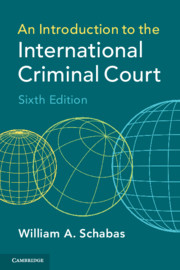Book contents
- An Introduction to the International Criminal Court
- An Introduction to the International Criminal Court
- Copyright page
- Contents
- Preface
- Abbreviations
- 1 Creation of the Court
- 2 The Court Becomes Operational
- 3 Jurisdiction
- 4 Triggering the Jurisdiction
- 5 Admissibility
- 6 General Principles of Criminal Law
- 7 Investigation and Pre-Trial Procedure
- 8 Trial and Appeal
- 9 Punishment
- 10 Victims of Crimes and Their Concerns
- 11 Structure and Administration of the Court
- Appendices
- Bibliography
- Index
10 - Victims of Crimes and Their Concerns
Published online by Cambridge University Press: 09 June 2020
- An Introduction to the International Criminal Court
- An Introduction to the International Criminal Court
- Copyright page
- Contents
- Preface
- Abbreviations
- 1 Creation of the Court
- 2 The Court Becomes Operational
- 3 Jurisdiction
- 4 Triggering the Jurisdiction
- 5 Admissibility
- 6 General Principles of Criminal Law
- 7 Investigation and Pre-Trial Procedure
- 8 Trial and Appeal
- 9 Punishment
- 10 Victims of Crimes and Their Concerns
- 11 Structure and Administration of the Court
- Appendices
- Bibliography
- Index
Summary
An important role for victims is one of the innovations of the Rome Statute. Victims may participate in the proceedings at virtually all stages. They may even adduce evidence under certain conditions and make motions to the Court. The Court may also award reparations to the victims. Reparations may be paid directly by the convicted person or out of the resources of the Trust Fund for Victims. The Trust Fund may also use its resources to assist victims as part of its assistance mandate, which operates alongside the reparations function and in a manner independent of the criminal proceedings.
Keywords
- Type
- Chapter
- Information
- An Introduction to the International Criminal Court , pp. 353 - 379Publisher: Cambridge University PressPrint publication year: 2020

